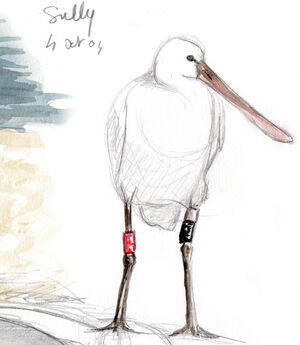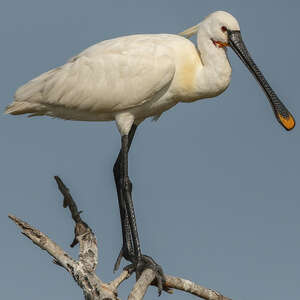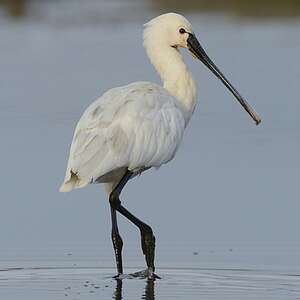Eurasian Spoonbill
Platalea leucorodia - Spatule blanche
Identification
Eurasian Spoonbill is a large bird with the appearance of a heron, with white plumage and unmistakeable with its long, wide, curiously wrinkled and spoon-shaped beak. The adult breeding bird has an orange-tinted crest on the nape and a collar of the same colour at the base of its neck. Its beak is black with a yellow tip. Areas of naked skin on the head turn yellow or red. The young bird can be recognised by its black-tipped feathers visible in flight, and its flesh-coloured beak. In the following year, the beak darkens and the feathers have a slowly fading spot, becoming all white when it reaches adult age.
Subspecific information 3 subspecies
- Platalea leucorodia leucorodia (Europe to n China, India and Sri Lanka)
- Platalea leucorodia balsaci (w Mauritania)
- Platalea leucorodia archeri (coasts of the Red Sea, Somalia)
Foreign names
- Spatule blanche,
- Espátula común,
- colhereiro-eurasiático,
- Löffler,
- kanalasgém,
- Lepelaar,
- Spatola,
- skedstork,
- Skjestork,
- lyžičiar biely,
- kolpík bílý,
- Skestork,
- kapustahaikara,
- becplaner comú,
- Flatnefur,
- warzęcha (zwyczajna),
- karošknābis,
- žličarka,
- Колпица,
- ヘラサギ,
- 白琵鹭,
- นกปากช้อนหน้าขาว,
- 白琵鷺,
Voice song and call
Habitat
Behaviour character trait
The Eurasian Spoonbill is gregarious and colonial during breeding season. They are usually seen in groups in shallow waters. While moving blindly and sometimes quickly, they search through the mud with horizontal sweeping motions of their beaks. Hunting in a group is probably more efficient and productive. When resting, they gather in resting spots or in groups of trees as they often perch in trees.
Flight
Dietfeeding habits
Reproduction nesting
In March, the adult Eurasian Spoonbills return to their nesting colony, often in trees, but also in wetlands. After the parading (mutual grooming, erect crest), the couple builds a nest of twigs and other strong materials in a tree or in reeds depending on the case. 3 to 5 eggs are laid in April or May depending on the latitude and incubated for 24 days. The chicks start flying at 7 weeks. Sexual maturity will not occur until the age of 3 or 4 years.
Geographic range
The Eurasian Spoonbill's range is vast. It stretches across the entire Eurasian continent at medium latitudes, but also on the Indian subcontinent. It is also found occasionally in Africa. The birds in Eurasia are migratory and winter, either in Africa for the Europeans or in India and China for the most oriental ones. A few pairs nest in France on the Atlantic coast and in the Camargue. These birds will spend the winter on the African Atlantic coast, at the Djoudj for example.
Threats - protection
IUCN conservation status
concern
in the Wild
threatened
evaluated
Considered endangered in the last century, the Eurasian Spoonbill population is currently slowly expanding due to protection, and the number of pairs was estimated to be between 8,500 and 15,000 in the early 2000s. The main problem for the species is the alteration of its nesting and feeding habitats, disturbances, rather than mortality. Poaching is probably only present in some winter places. Poisonings by pesticides or due to botulism must exist but are impossible to quantify. Their impact must be smaller.
Sources of information
- IOC World Bird List (v15.1), Gill, F and D Donsker (Eds). 2025-12-07.
Other sources of interest
 Specification sheet created on
29/07/2023 by Jean François
Specification sheet created on
29/07/2023 by Jean FrançoisTranslation by AI Oiseaux.net
© 1996-2026 Oiseaux.net
- Accipitriformes
- Aegotheliformes
- Anseriformes
- Apodiformes
- Apterygiformes
- Bucerotiformes
- Caprimulgiformes
- Cariamiformes
- Casuariiformes
- Charadriiformes
- Ciconiiformes
- Coliiformes
- Columbiformes
- Coraciiformes
- Cuculiformes
- Eurypygiformes
- Falconiformes
- Galliformes
- Gaviiformes
- Gruiformes
- Leptosomiformes
- Mesitornithiformes
- Musophagiformes
- Nyctibiiformes
- Opisthocomiformes
- Otidiformes
- Passeriformes
- Pelecaniformes
- Phaethontiformes
- Phoenicopteriformes
- Piciformes
- Podargiformes
- Podicipediformes
- Procellariiformes
- Psittaciformes
- Pterocliformes
- Rheiformes
- Sphenisciformes
- Steatornithiformes
- Strigiformes
- Struthioniformes
- Suliformes
- Tinamiformes
- Trogoniformes































